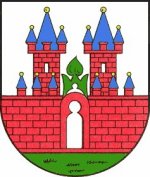|
|
Guide to Bach Tour
Nienburg (Saale) [V] |
|
Contents |
|
Description | History
J.S. Bach: Connection | Events in Life History | Performance Dates of Vocal Works | Festivals & Cantata Series
Features of Interest | Information & Links
Photos: Part 1 | Maps |
|
 |
|
Description |
|
Nienburg (Saale) is is a 1000 year old small historical town in the district of Salzlandkreis in Saxony-Anhalt, Germany. It is located in the lower Saale valley, approx. 5 km northeast of Bernburg. In June 2005 its population was 4,449. |
|
Country: Germany | State: Saxony-Anhalt | District: Salzlandkreis | Area: 79.10 km² | Population: 6,460 (December 2015) |
|
History |
|
The history of Nienburg is long and distinguished. Nienburg is first mentioned in travel records dating from 961. As early as the 8th century, a castle there protected the eastern edge of the Carolingian empire. Between 930 and 950, a new castle (Neue Burg or Nienburg) was erected on a promontory strategically located at the confluence of the Saale and Bode rivers. This represented the crossroads of the north-south Halle (Saale)-Magdeburg salt route and a major east-west trade and military artery. In 975, a group of Benedictine monks was sent to live in the castle with the mission of Christianizing the region’s Slavic Sorb population. They expanded and modified the castle into a fortified monastery. In 1004 the monastery church was consecrated in the presence of King Heinrich 11 (r. 1002-1024; later Holy Roman Emperor, r. 1014-1024). The medieval centre of the town is occupied by the Benedictine monastery, Kloster Nienburg (Nienburg Abbey/Monastery), whicj is beautifully preserved to this day.
After the Reformation and the Peasants’ War (1524-1525), the monastery was transferred in 1563 to the princes of Anhalt-Köthen. In 1623, during the Thirty Years' War, part of the town was destroyed. The monastery was converted into a residential palace for the dowager princesses c1690, with the massive fortress-like church of St. Mary’s and St. Cyprian’s serving as the castle church. Almost nothing remains of the monastery/palace except for the church. It forms part of the “Romanesque Trail” (Strasse der Romanik), a network connecting numerous medieval cultural monuments in Saxony-Anhalt.
In 1825 an early suspension bridge over the river Saale was constructed, but because of unforeseen vibrations it collapsed during the inauguration festivities, resulting in over a hundred casualties.
Comment: There is another town named Nienburg, the capital of the district Nienburg, in Lower Saxony, Germany. |
|
Personalities |
|
Gottfried Bandhauer (1790-1837), master builder and designer
Gustav Flügel, piano composer
Hodo I. (c. 930-983), buried in the Kloster Nienburg (Saale)
Ibrahim ibn Jaqub, traveler, first mention of Nienburg
Friedrich Lutzmann (1859-1930), automobile pioneer
Odo I, Margrave of the Saxon Ostmark (around 930-983), buried in the monastery Nienburg an der Saale
Annalista Saxo, Nienburg chronicler
Gisela Agnes von Rath (1669-1740), Countess of Nienburg, princess of Anhalt-Köthen
Ronny Siewert, chef, awarded a star in the Michelin Guide
Sources: Wikipedia (December 2017); Robert L. Marshall & Traute M. Marshall: Exploring the World of J.S. Bach - A Traveller's Guide (University of Illinois Press, 2016), pp 174-175 |
| |
|
Bach Connection (1716) |
|
J.S. Bach most likely met his future patron and employer, Prince Leopold of Anhalt-Köthen (r. 1716-1728), in the year 1716, while in the service of the dukes of Weimar. The occasion was the wedding of Leopold’s older sister, Princess Eleonore Wilhelmine (1696-1726) with the Weimar coregent, Duke Ernst August of Weimar (r. 1707-1748).
The festivities took place on Ianuary 24, 1716, in the town of Nienburg, located 22 km/13.5 miles northwest of Köthen at the residential palace of Leopold’s widowed mother Gisela Agnes (1669-1740). Salomo Franck (1659-1725), court poet and J.S. Bach’s principal Weimar librettist, provided the text for a wedding cantata. A court document records payment of forty-five florins and fifteen groschen “to the Secretary of the consistory Franck, ... Concertmaster Bach... and the printer, for Carmina [songs] presented, April 4, 1716.” The reference to J.S. Bach in the payment record strongly suggests that he set the text to music, now lost (BDOK II, no. 77). The text, however, may survive in S. Franck's Heliconische Ehren-, Liebes-, und Trauer-Fackeln (1718), which includes several congratulatory poems and the wedding text, Diana, Amor, Apollo, Ilmene.
J.S. Bach presumably accompanied the duke on the ca. 14s-km/9o-mile journey north from Weimar for the royal wedding, setting out immediately after the performance of his cantata, Mein Gott, wie lung, ach lange, BWV 155, on Sunday, January 19, 1716. Such festivities typically lasted several days and offered many occasions for music-making. Prince Leopold was no doubt favorably impressed by J.S. Bach’s offerings. Whether the other participating musicians were members of the Weimar court ensemble or Leopold’s recently revived Köthen kapelle (or both) is unknown. In any event, by August 5, 1717, the prince had appointed J.S. Bach kapellmeister to the Köthen court, a post he was not able to assume until December of that year.
J.S. Bach's presumable route from Weimar:
Weimar - Jena - Naumburg - Merseburg - Halle (Saale) - Nienburg.
Literature: Zürner 1753,- BDOK 11; Terry 1933; Smend 1985; Hoppe 1997; Cobbers 2011.
Source: Robert L. Marshall & Traute M. Marshall: Exploring the World of J.S. Bach - A Traveller's Guide (University of Illinois Press, 2016), pp 174-175 |
|
Events in Life History of J.S. Bach: See above. |
|
Performance Dates of J.S. Bach’s Vocal Works : None. |
|
Bach Festivals & Cantata Series : None. |
| |
|
Features of Interest |
|
Klosterkirche St. Marien und St. Cyprian (St. Mary and St. Cyprian Monastery Church): See History above. |
|
Information & Links |
|
Nienburg, Saxony-Anhalt (Wikipedia) [English]
Nienburg (Saale) (Wikipedia) [German]
Nienburg Saale (Official Website) [German / partly English] |
| |
|
Prepared by Aryeh Oron (April 2018) |
|
|